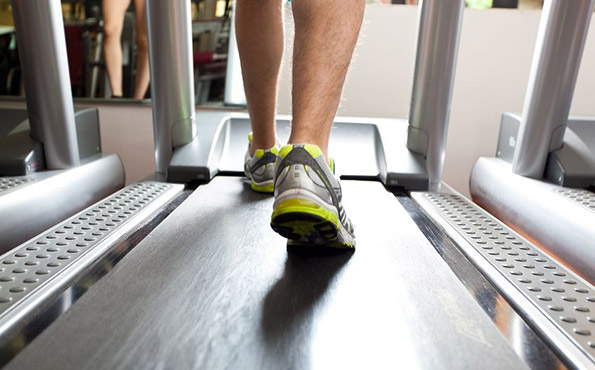Does Cardio Burn Muscle?

Everyone wants to be the guy who’s completely shredded. A ripped tight torso, stacked up abs and veins wrapped around their figure like vines.
It’s a vision of your future self, but there’s just one thing holding you back – cardio: does it get you shredded or does it just hold you back?
There’s no doubt that it’s a great way to stay in shape, and it’s even better for burning fat, but does cardio burn muscle?
It’s a logical thought, and debates on this topic have echoed around the gym floors for years.
But now it’s time to set the story straight.
We’re putting an end to the age old question, both for you, and your physique. Contrary to what you might hear, there’s not a lot of evidence that links cardio to a catabolic state – and can actually improve your gains.
We’ve done a lot of research and here’s why some guys think otherwise:
Why most people think cardio burns muscle
What they’ve seen on TV
People who do a lot of cardio, like endurance runners, tend to be a skinny build. However, they’re at the very far end of the spectrum. Running didn’t do this – they choose to have that build and diet for it especially as it allows them to carry the least amount of weight when it comes to running long distances.
Although they choose to be this way, there’s a lot of gym superstition that if you even go near a treadmill you become one of them. This couldn’t be further from the truth, to get to that kind of level takes years of training and intense dieting, to be the best that they can pound for pound.
What they’ve seen in the gym
You hear horror stories about guys going on a cut and losing all their gains. They hit the cardio hard and their mass seems to disappear.
It’s not so much the cardio that is the culprit here, it’s the calories. Guys like this want results fast, and do anything to get them. This usually involves putting themselves on a drastic calorie deficit. Sure, it helps burn fat quicker, but it forces the body to burn muscle to keep up with sheer amount of energy being spent.
Cardio isn’t the cause here. It’s the final nail in the coffin with a lot of other factors that are put a lot of physical demand on the body’s outgoings. With a proper diet and reducing your cardio to a few times per week in 20 – 40 minute sessions, you can lose the fat, while still maintaining your gains.
What Cardio actually does
Cardio doesn’t burn muscle, in fact, it improves it.
If you’re doing cardio to cool down after a workout, you won’t just improve your stamina, your entire performance will benefit.
Here are some of the ways cardio and the weights go together:
- Quicker Muscle Recovery
- Better Performance, Stamina and Work Capacity
- Increased Insulin Sensitivity
As you can see, there are a lot of benefits, and it can be a serious game changer to your routine. Let’s run through them:
Improved Muscle Recovery
One of the mains things cardiovascular activity does for the body is improve circulation.
This helps you in two ways:
- Increases Overall Muscle Mass
- Combats Delayed Onset Muscle Soreness (DOMS)
The increased blood flow in the body is great for your gains. After training a muscle group, you need time to recover while the body repairs the damage. Performing light cardio after a session may be painful to that area but it increases the flow of nutrients to the muscle group and shortens your recovery time between workouts.
In addition, this also lessens the pain of DOMS (Delayed Onset Muscle Soreness) that usually follows the next morning.
We’d like to point out, if you’ve trained lower body, you want cardio that is leg-dominant e.g. a bike machine. Likewise for upper body you want to be using the row machine or rope pull machine.
The idea is to increase the flow around the muscle group that you’ve worked in your session to get the best results.
Better Performance and Work Capacity
One of the big things that cardio provides you with is stamina, and if you’ve been bulking for a while, chances are you’ve been dealing with heavy weights and a low rep range.
This is good for pure mass, but it isn’t ideal when you’re looking to shred down. In a cut you’ll start adding more high-rep ranged sets to your workouts, sculpting out your muscle to attain that textbook ripped physique.
However, if you’ve not been doing these kind of sets before you started your cut, it’s not going to be a seamless transition. This is where cardio comes in. Building up stamina and endurance in the muscles, high rep sets become easier to do and you’ll start to see your progress come together at a much faster rate.
This can train for longer and go further than you used to. This added endurance is also a lot easier to maintain than it is create, once you’re at that stage, a cardio session every now and again should be enough to keep your stamina in check.
Not to mention the added fat burning benefits that comes from additional cardio which can really help to lean out those abs.
Improved Insulin Sensitivity
An added bonus to doing regular cardio a few times a week is how it affects your blood sugar levels. Frequent cardio sessions have been seen to support insulin sensitivity which helps towards how you process carbs.
Better insulin sensitivity also helps with your absorption of nutrients, more amino acids and carbs can be taken to your muscles which can help towards recovery and growth at faster rate than usual.
What you should avoid doing
More Cardio = More Problems
Although cardio can help improve your gains – and believe us, it does, there are limits as to what you should be doing for the best results. The temptation to go ‘cardio crazy’ to look shredded can have some major drawbacks on your progress.
Most of the time it’s not the cardio itself that’s causing the problem, it’s the aftermath it has on you.
We recommend sticking to around 20 – 40 minutes of the good stuff every few sessions to ensure you’re getting the benefits. Doing too much can cause problems such as:
Injuries
Repetitive Strain Injuries (RSI) can occur anywhere where there’s constant joint movement. Unfortunately for us, that’s all cardio involves.
Activities like long distance running or endurance training can inflame joints and leads to discomfort and injuries. Once you’re in that position, your chances of getting any serious work done in the gym afterwards is slim, and may sink your progress for that week.
Exhaustion
By it’s very nature, cardio is exhausting. Depending on how you do it, you can really affect your progress – and not in a good way.
Short demanding bursts like sprint sessions or High Intensity Interval Training (HIIT) causes instant fatigue. The ‘wipe-out effect’ from these activities drain any intensity or aggression you’ll could have for an upcoming gym session, and offers little benefit on your quest for gains.
Similar results are seen with long distance or endurance training like marathon running – but these effects are on a larger scale. After running for many miles and hours, your body needs a lot of time to recover.
This can take a few days, and it’ll be harder for you to focus on your lifts to make the gains you deserve – which takes us to our next point:
Overtraining
If you do too much cardio your body can get overwhelmed. When you train too hard, too frequently your body can’t recovery quick enough before the next session. You stop making gains, and sometimes even see a decrease in your performance.
There’s been a lot of studies into this, but the most compelling one comes from 44 subjects competing in the 2009 TransEurope-FootRace – a 64 day event that covered 4,488km. [1]
Although the race helped towards getting these athletes absolutely shredded (on average each racer lost 50% of their visceral body fat) in this case they saw cardio burn muscle.
Due to the amount of pressure on the body, runners lost on average 7% of the muscle mass in their legs, on top of that there was a significant number of joint injuries from overtraining.
Conclusion – Does Cardio Burn Muscle?
So, does cardio burn muscle? No.
Although it can be drain on both your gym time and your energy – it’s cardio after weights is definitely worth it. Light intensity sessions for 20 – 40 minutes a couple of times a week can offer huge benefits towards improving your gains.
It helps towards improving muscle recovery by increasing nutrient flow in the body, and improves stamina which is essential to the high-rep work used when cutting.
From a dietary perspective it also enables you to get more out of your food, with increased insulin sensitivity that can greatly increase your body’s absorption rate come dinner time.
If you’re looking to ripped, you need to be pumping iron and eating right, but you’re also going to want to some cardio in there.



